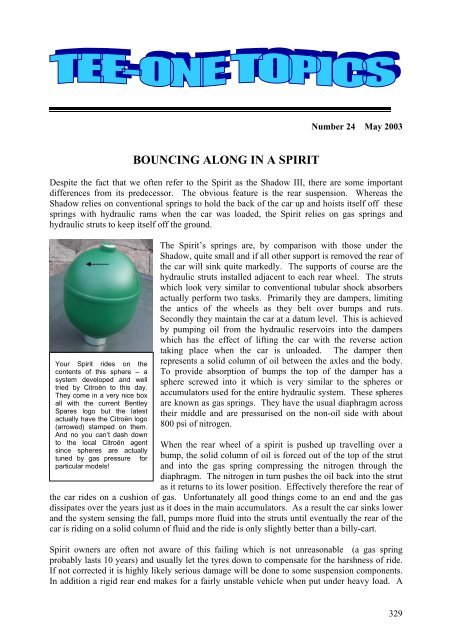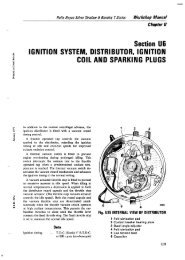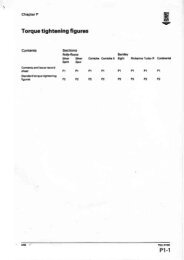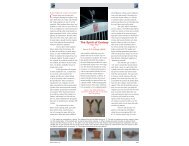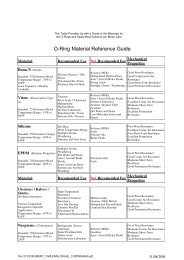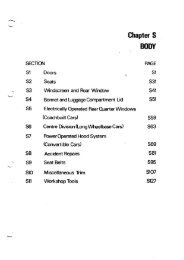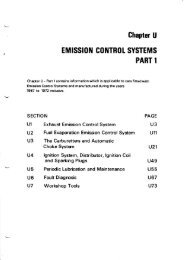bouncing along in a spirit - Rolls-Royce Owners' Club of Australia
bouncing along in a spirit - Rolls-Royce Owners' Club of Australia
bouncing along in a spirit - Rolls-Royce Owners' Club of Australia
You also want an ePaper? Increase the reach of your titles
YUMPU automatically turns print PDFs into web optimized ePapers that Google loves.
Number 24 May 2003<br />
BOUNCING ALONG IN A SPIRIT<br />
Despite the fact that we <strong>of</strong>ten refer to the Spirit as the Shadow III, there are some important<br />
differences from its predecessor. The obvious feature is the rear suspension. Whereas the<br />
Shadow relies on conventional spr<strong>in</strong>gs to hold the back <strong>of</strong> the car up and hoists itself <strong>of</strong>f these<br />
spr<strong>in</strong>gs with hydraulic rams when the car was loaded, the Spirit relies on gas spr<strong>in</strong>gs and<br />
hydraulic struts to keep itself <strong>of</strong>f the ground.<br />
Your Spirit rides on the<br />
contents <strong>of</strong> this sphere – a<br />
system developed and well<br />
tried by Citroën to this day.<br />
They come <strong>in</strong> a very nice box<br />
all with the current Bentley<br />
Spares logo but the latest<br />
actually have the Citroën logo<br />
(arrowed) stamped on them.<br />
And no you can’t dash down<br />
to the local Citroën agent<br />
s<strong>in</strong>ce spheres are actually<br />
tuned by gas pressure for<br />
particular models!<br />
The Spirit’s spr<strong>in</strong>gs are, by comparison with those under the<br />
Shadow, quite small and if all other support is removed the rear <strong>of</strong><br />
the car will s<strong>in</strong>k quite markedly. The supports <strong>of</strong> course are the<br />
hydraulic struts <strong>in</strong>stalled adjacent to each rear wheel. The struts<br />
which look very similar to conventional tubular shock absorbers<br />
actually perform two tasks. Primarily they are dampers, limit<strong>in</strong>g<br />
the antics <strong>of</strong> the wheels as they belt over bumps and ruts.<br />
Secondly they ma<strong>in</strong>ta<strong>in</strong> the car at a datum level. This is achieved<br />
by pump<strong>in</strong>g oil from the hydraulic reservoirs <strong>in</strong>to the dampers<br />
which has the effect <strong>of</strong> lift<strong>in</strong>g the car with the reverse action<br />
tak<strong>in</strong>g place when the car is unloaded. The damper then<br />
represents a solid column <strong>of</strong> oil between the axles and the body.<br />
To provide absorption <strong>of</strong> bumps the top <strong>of</strong> the damper has a<br />
sphere screwed <strong>in</strong>to it which is very similar to the spheres or<br />
accumulators used for the entire hydraulic system. These spheres<br />
are known as gas spr<strong>in</strong>gs. They have the usual diaphragm across<br />
their middle and are pressurised on the non-oil side with about<br />
800 psi <strong>of</strong> nitrogen.<br />
When the rear wheel <strong>of</strong> a <strong>spirit</strong> is pushed up travell<strong>in</strong>g over a<br />
bump, the solid column <strong>of</strong> oil is forced out <strong>of</strong> the top <strong>of</strong> the strut<br />
and <strong>in</strong>to the gas spr<strong>in</strong>g compress<strong>in</strong>g the nitrogen through the<br />
diaphragm. The nitrogen <strong>in</strong> turn pushes the oil back <strong>in</strong>to the strut<br />
as it returns to its lower position. Effectively therefore the rear <strong>of</strong><br />
the car rides on a cushion <strong>of</strong> gas. Unfortunately all good th<strong>in</strong>gs come to an end and the gas<br />
dissipates over the years just as it does <strong>in</strong> the ma<strong>in</strong> accumulators. As a result the car s<strong>in</strong>ks lower<br />
and the system sens<strong>in</strong>g the fall, pumps more fluid <strong>in</strong>to the struts until eventually the rear <strong>of</strong> the<br />
car is rid<strong>in</strong>g on a solid column <strong>of</strong> fluid and the ride is only slightly better than a billy-cart.<br />
Spirit owners are <strong>of</strong>ten not aware <strong>of</strong> this fail<strong>in</strong>g which is not unreasonable (a gas spr<strong>in</strong>g<br />
probably lasts 10 years) and usually let the tyres down to compensate for the harshness <strong>of</strong> ride.<br />
If not corrected it is highly likely serious damage will be done to some suspension components.<br />
In addition a rigid rear end makes for a fairly unstable vehicle when put under heavy load. A<br />
329
simple test for the condition is to lay <strong>in</strong>to the back <strong>of</strong> the car and bounce it up and down. If the<br />
gas spr<strong>in</strong>gs are depleted the back will hardly bounce.<br />
The cure is simple and well with<strong>in</strong> the<br />
abilities <strong>of</strong> an owner with reasonable<br />
mechanical aptitude. The procedure is;<br />
• Exhaust the two hydraulic<br />
systems – simply pump<strong>in</strong>g the<br />
brake pedal a zillion times will<br />
achieve this.<br />
• Attach plastic hoses to the rear<br />
strut bleed nipples which are<br />
mounted on the <strong>in</strong>side <strong>of</strong> the<br />
body beneath the rear doors.<br />
Sitt<strong>in</strong>g on its haunches hav<strong>in</strong>g had its struts exhausted. Token<br />
spr<strong>in</strong>gs that are hold<strong>in</strong>g this car up are there to avoid the<br />
Citroën malady <strong>of</strong> the car collaps<strong>in</strong>g when the suspension<br />
fails.<br />
• Open the nipples and the car<br />
will drop about 5 <strong>in</strong>ches as the<br />
struts exhaust their oil contents.<br />
• Open the boot. Disconnect the battery and remove the carpet board at the back <strong>of</strong> the<br />
boot which will <strong>in</strong>volve unscrew<strong>in</strong>g the ferrule around the battery cut-out switch. You<br />
will now be able to see the two gas spr<strong>in</strong>gs high up <strong>in</strong> the boot adjacent to the fuel tank.<br />
Remove the battery cut-out switch mount and sw<strong>in</strong>g the switch out <strong>of</strong> the way.<br />
• Put some cloth under the gas spr<strong>in</strong>g to soak up the bit <strong>of</strong> oil that will leak out when it is<br />
unscrewed.<br />
• To unscrew the unit you will need<br />
a strap spanner – an oil filter<br />
remover will usually do the job. If<br />
oil starts to squirt out <strong>of</strong> the threads<br />
– you have not exhausted the<br />
accumulators but that would be<br />
unlikely wouldn’t it<br />
• Us<strong>in</strong>g a new rubber seal, screw <strong>in</strong><br />
the new gas spr<strong>in</strong>gs and tighten<br />
them firmly.<br />
• Reassemble the switch mount and<br />
the boot fitt<strong>in</strong>gs.<br />
• The next task is to bleed the struts<br />
and gas spr<strong>in</strong>gs. Put some weight<br />
<strong>in</strong> the boot to activate the levell<strong>in</strong>g<br />
valves, make sure the two<br />
hydraulic m<strong>in</strong>eral oil reservoirs are<br />
full and that you have plenty <strong>of</strong><br />
bottles say 6, <strong>of</strong> fresh oil.<br />
And here is what you will f<strong>in</strong>d hav<strong>in</strong>g got the back <strong>of</strong> the<br />
boot uncovered. This is the right hand side show<strong>in</strong>g the<br />
sphere and <strong>in</strong> front <strong>of</strong> it the battery switch which clearly<br />
needs to be moved to one side. The Factory recommends<br />
that the mount<strong>in</strong>g block for the sphere (seen beh<strong>in</strong>d the<br />
coiled pipe) be removed to unscrew the sphere. . This is<br />
unecessary as there is sufficient room to get the th<strong>in</strong>g out<br />
without trauma. The left hand side is very accessable<br />
330
• Open both bleed nipples for the struts<br />
(you probably haven’t closed them<br />
from when you exhausted the units)<br />
and start the eng<strong>in</strong>e.<br />
• Let the oil flow <strong>in</strong>to conta<strong>in</strong>ers until it<br />
is clear and free <strong>of</strong> bubbles. Keep an<br />
eye on the reservoirs mak<strong>in</strong>g sure they<br />
don’t empty otherwise you will be<br />
bleed<strong>in</strong>g the whole car!<br />
• When the oil runs clear close the bleed<br />
nipples and the car will rise to its<br />
correct height.<br />
• Enjoy your new ride and pump the<br />
tyres up aga<strong>in</strong>!<br />
And here is the mount<strong>in</strong>g block on top <strong>of</strong> the right<br />
hand strut show<strong>in</strong>g the threaded entrance for the gas<br />
spr<strong>in</strong>g<br />
Fully erect<br />
and ready to<br />
go. The<br />
height <strong>of</strong> the<br />
rear end is no<br />
<strong>in</strong>dication <strong>of</strong><br />
the condition<br />
<strong>of</strong> the gas<br />
spr<strong>in</strong>gs s<strong>in</strong>ce<br />
the self<br />
levell<strong>in</strong>g will<br />
compensate<br />
for any drop<br />
<strong>in</strong> body<br />
height.<br />
SHOCK, HORROR<br />
Neil Garvey our rabid treasurer recently negotiated a bank account with a local f<strong>in</strong>ancial<br />
<strong>in</strong>stitution and was startled to see the bank <strong>of</strong>ficial recoil when he advised that the account was<br />
for the Tee One Group. Seems the Tewun someth<strong>in</strong>g is on a list <strong>of</strong> highly undesirable<br />
organisations which Mr Bush has been pursu<strong>in</strong>g <strong>of</strong> late. This will expla<strong>in</strong> why we have<br />
followed the bank <strong>of</strong>ficials advice and popped a hyphen <strong>in</strong>to the name!<br />
331
MINDER, MENTOR, MATE.<br />
As we venture <strong>in</strong>to the deeper end <strong>of</strong> the pond (<strong>in</strong>ternational now, don't you know) this may be a<br />
good time to reflect on some <strong>of</strong> our not so distant history.<br />
Others will recount the beg<strong>in</strong>n<strong>in</strong>gs <strong>of</strong> the group so I shall focus on what caused some <strong>of</strong> us to<br />
"break away" from the orig<strong>in</strong>al "self help" entity with<strong>in</strong> the ACT branch <strong>of</strong> the RROC Inc.<br />
<strong>Australia</strong>. In truth, when we left, there was no functional "self help" entity to speak <strong>of</strong> <strong>in</strong> the<br />
Branch as most <strong>of</strong> the doers came away with us.<br />
Over the years, local demand for a ma<strong>in</strong>tenance facility for our marque dw<strong>in</strong>dled until f<strong>in</strong>ally a<br />
few years ago the last service franchise for <strong>Rolls</strong>-<strong>Royce</strong> and Bentley cars gave up. That left us<br />
with only limited options and they were:<br />
• to drive our cars and hope that noth<strong>in</strong>g went wrong,<br />
• to f<strong>in</strong>d a mechanic who would service them for us ("have a look at it for you, mate"),<br />
• to quietly leave the car <strong>in</strong> the garage if it started to exhibit any malfunctions,<br />
• to drive them to the nearest RR servic<strong>in</strong>g facility (Sydney for us, if <strong>in</strong>deed the car would<br />
travel that far, <strong>in</strong>curr<strong>in</strong>g all <strong>of</strong> the additional expenses <strong>along</strong> the way.),<br />
• to sell the car and be rid <strong>of</strong> the expensive "lemon"<br />
OR<br />
as <strong>in</strong> we <strong>in</strong> the TEE-ONE group have chosen to do,<br />
• to break out the manuals, roll up the sleeves and "do it ourselves".<br />
The shar<strong>in</strong>g <strong>of</strong> <strong>in</strong>formation and methods went hand <strong>in</strong> glove with the "many hands make light<br />
work" pr<strong>in</strong>ciple. Bill record<strong>in</strong>g our jobs <strong>in</strong> the now widely appreciated Tee-One Topics and<br />
Wayne Wardman document<strong>in</strong>g many <strong>of</strong> the tasks on video have gone a long way to ratify<strong>in</strong>g<br />
our existence.<br />
There was a concerted effort by a rather <strong>in</strong>trospective group to neutralise the rambunctious<br />
element who seemed to be gett<strong>in</strong>g an unseemly amount <strong>of</strong> pleasure <strong>in</strong> us<strong>in</strong>g and fix<strong>in</strong>g their<br />
cars, by rais<strong>in</strong>g the tired old spectre <strong>of</strong> "litigation if someth<strong>in</strong>g goes wrong". Although some <strong>of</strong><br />
us argued that many, no, most <strong>of</strong> the car clubs <strong>in</strong> <strong>Australia</strong> (and <strong>in</strong>deed the world at large)<br />
operated on the very pr<strong>in</strong>ciples <strong>of</strong> help<strong>in</strong>g each other without fear <strong>of</strong> hav<strong>in</strong>g the pants sued <strong>of</strong>f<br />
them, the <strong>in</strong>ward lookers were determ<strong>in</strong>ed to carry the day. We got the message and as they did<br />
not seem to want our <strong>in</strong>put we 'output' ourselves and have gone from strength to strength.<br />
There will be a number <strong>of</strong> versions <strong>of</strong> the above, and really, it doesn't matter whose story one<br />
believes, because all one needs to do is turn up at a Tee-One work<strong>in</strong>g bee to get the true<br />
message. One will see us all squirm<strong>in</strong>g with delight as we cover ourselves <strong>in</strong> grease and<br />
Frederick Henry <strong>Royce</strong>'s product <strong>in</strong> glory and realise that it's about the cars, not<br />
personalities!!!!! If Fred was to magically return, I th<strong>in</strong>k that he'd jo<strong>in</strong> <strong>in</strong>, don't you<br />
Now that I have you either nodd<strong>in</strong>g <strong>in</strong> agreement or gnash<strong>in</strong>g your teeth <strong>in</strong> outrage, let me get to<br />
the ma<strong>in</strong> thrust <strong>of</strong> this article, and that is a pr<strong>of</strong>ile <strong>of</strong> our patron,<br />
332
Robert Skillen Esquire.<br />
Bob was bitten by the<br />
automobile bug long ago.<br />
He is not young anymore.<br />
In fact, he was born<br />
before the New Phantom<br />
was, so that makes him<br />
pretty "experienced".<br />
There you go Bob, tactful<br />
enough for you Bob<br />
Big cap, big car, big happy!<br />
<strong>in</strong>troduced his young<br />
family to the joys <strong>of</strong> car<br />
collect<strong>in</strong>g by br<strong>in</strong>g<strong>in</strong>g<br />
home a wonderful old<br />
Packard he'd just purchased. His gracious lady Dawn told me you could have heard a p<strong>in</strong> drop at<br />
home....... for about three days!!!! Anyway, they got over the shock and got about the bus<strong>in</strong>ess<br />
<strong>of</strong> enjoy<strong>in</strong>g the car and build<strong>in</strong>g memories. When Bob sold it for substantially more than he paid<br />
for it, he set a precedent which was followed for every substantial car they owned (and there<br />
were lots <strong>of</strong> them). See the list below.<br />
1934 Packard sedan (purchased 1970)<br />
1939 Packard convertible (purchased 1973)<br />
1951 Delahaye (purchased 1975) What a stunn<strong>in</strong>g vehicle that was!!!!!<br />
1934 Phantom II (purchased 1980)<br />
1927 Packard sedan (purchased 1984)<br />
1948 Bentley MkVI body by James Young (purchased 1985) This car was bought and exported<br />
to Holland <strong>in</strong> the mid '90's.<br />
1957 Silver Cloud (purchased 1996). The previous owner traded this beautiful car <strong>in</strong> on a Toyota<br />
4 wheel drive. Life can be stranger than fiction sometimes.<br />
Bob and Dawn were keen members <strong>of</strong> the Victorian branch <strong>of</strong> the RROC and saw many<br />
changes <strong>in</strong> their time. Bob took up the challenge and did a st<strong>in</strong>t as club secretary, so by the time<br />
he arrived here <strong>in</strong> Canberra he was well credentialed. The first member <strong>of</strong> the RROC ACT<br />
Branch the Skillens saw was David Miller who demanded to see the 1948 James Young bodied<br />
two door Bentley (one <strong>of</strong> four made). For those who did not meet David, he was a larger than<br />
life, boom<strong>in</strong>g and hearty bloke who was likely to sweep you <strong>along</strong> with his enthusiasm.<br />
Shortly after meet<strong>in</strong>g David, Dawn and Bob became members <strong>of</strong> the RROC (ACT). They<br />
enjoyed the halcyon days <strong>of</strong> rallies and picnics where they were always on hand to lend one.<br />
They were stalwarts when the hard yakka was on and they even opened up their own home to<br />
sort out and store the many hundreds <strong>of</strong> gift bags required for at least two Canberra based<br />
federal rallies. A huge effort for a group, let alone a couple. the promised help never<br />
materialis<strong>in</strong>g. They have too much class to br<strong>in</strong>g that up; I haven't!<br />
Bob became Branch President and tells me he enjoyed it immensely. I met him some time after<br />
his tenure and as the Branch was <strong>in</strong> good shape, I can only surmise that he did the excellent job<br />
333
others tell me he did. My first meet<strong>in</strong>g with Dawn and Bob was at a Branch out<strong>in</strong>g at<br />
Yarralumla Park. A beautifully restored grey 1948 two door Bentley wheeled gracefully <strong>in</strong>to the<br />
car park with a white Tam O'Shanter capped Bob at the wheel. I've got the cap now Bob, Dawn<br />
gave it to me and you can't have it back! I wasted no time strik<strong>in</strong>g up a conversation with him<br />
as I recognised the awful "<strong>in</strong>verted bath tub" shape <strong>of</strong> his car. My own father had owned the<br />
1949 "Wentworth" a<br />
unique Park Ward Silver<br />
Wraith which looks very<br />
similar. There were other<br />
similarities too. Both cars<br />
had been "display stand"<br />
cars at the Earl's Court<br />
Motor Show. Oddly<br />
enough, I now own a<br />
James Young bodied Mk<br />
VI two door Bentley<br />
which was also a "stand"<br />
car at the Earl's Court<br />
Motor Show <strong>in</strong> 1950.<br />
Fate moves <strong>in</strong> mysterious<br />
ways.<br />
Glamourous old girl a<strong>in</strong>’t she!<br />
Bob went on to own a beautiful 1957 Silver Cloud (SED 51) which graced the cover <strong>of</strong> our<br />
Federal magaz<strong>in</strong>e, a copy <strong>of</strong> which John Blatchley has personally signed for him. Mr. Blatchley<br />
was the designer <strong>of</strong> that model among others and <strong>in</strong> a personal note to Bob remarked that it was<br />
that model which upon reflection, gave him the most pleasure. What a lovely endorsement <strong>of</strong><br />
Bob's beautiful car. I have fond memories <strong>of</strong> SED 51. Bob and I spent many enjoyable hours<br />
'bump<strong>in</strong>g our gums' about everyth<strong>in</strong>g and noth<strong>in</strong>g as we endeavoured to rid it <strong>of</strong> over 40 years<br />
<strong>of</strong> grime. The car served them well and although it once failed to proceed on the way to Swan<br />
Hill <strong>in</strong> Victoria, it was merely a faulty fuel pump which decided to fail miles from nowhere.<br />
When the time came for Bob to bow out <strong>of</strong> the limelight, Dawn took a turn and became Senior<br />
Vice President. The efficiency displayed when Dawn chaired the meet<strong>in</strong>gs exposed her<br />
undisclosed expertise <strong>in</strong> club management. She had held the post <strong>of</strong> President <strong>of</strong> the Yowani<br />
Golf <strong>Club</strong> and was well prepared for our little branch meet<strong>in</strong>gs.<br />
A couple <strong>of</strong> years ago, Dawn and Bob decided that they could not contribute to the Branch<br />
anymore so they tendered their resignation. That action was typical <strong>of</strong> their modus operandi.<br />
They do th<strong>in</strong>gs while they can and then when they feel they can no longer 'do their share' they<br />
firmly close that chapter <strong>in</strong> their book <strong>of</strong> life. They didn't reckon on my determ<strong>in</strong>ation to take<br />
advantage <strong>of</strong> every bit <strong>of</strong> wisdom Bob has gathered over the years though. The body might not<br />
be as firm as it was Bob, but the m<strong>in</strong>d is still able. With that <strong>in</strong> m<strong>in</strong>d, I asked the then <strong>in</strong>fant Tee<br />
One group whether we wanted and warranted a Patron. They said "yes" on both accounts and it<br />
was my honour and pleasure to <strong>of</strong>fer Robert Skillen the post. He accepted. and I for one am very<br />
glad he did.<br />
The years have slowly caught up with Bob and he gradually put away those "toys" which gave<br />
Dawn and him so much pleasure. He is less mobile these days and spends most <strong>of</strong> his time<br />
334
ead<strong>in</strong>g. He "devours" the Tee One Topics (Dawn's words) and cont<strong>in</strong>ues to have firm views on<br />
many subjects perta<strong>in</strong><strong>in</strong>g to our group. He was delighted to see how the TEE ONE group<br />
developed and has given me many <strong>in</strong>sightful po<strong>in</strong>ters <strong>in</strong> the course <strong>of</strong> our conversations.<br />
I'll end this with someth<strong>in</strong>g Bob told me <strong>in</strong> one <strong>of</strong> our many conversations. "Never rust out<br />
George, do th<strong>in</strong>gs while you can so that you will have no regrets when you can't."<br />
Now who <strong>in</strong> their right m<strong>in</strong>d would argue with that<br />
See you at the next meet.<br />
George<br />
<br />
A MENTAL MEANDER<br />
A friend lent me an old publicity blurb which was <strong>in</strong> pretty poor shape but there was enough <strong>of</strong><br />
it to appreciate the contribution Citroën has made to the suspension <strong>of</strong> the cars <strong>of</strong> the world and<br />
more specifically to the bulk <strong>of</strong> the <strong>Rolls</strong>-<strong>Royce</strong>s we ride <strong>in</strong> today. The follow<strong>in</strong>g is a distillation<br />
<strong>of</strong> the document flavoured with a few <strong>of</strong> my thoughts!<br />
A COURAGOUS LEAP<br />
The technological leap <strong>of</strong> the Factory with the <strong>in</strong>troduction <strong>of</strong> a hydro elastic system <strong>of</strong><br />
suspension and brakes has to be admired. Historians one day might give an account <strong>of</strong> the<br />
brawls that must have ensued at Board level to sanction such a venture. Not<strong>in</strong>g that the new<br />
Phantom has air suspension I thought we should give some publicity to the creators <strong>of</strong> the hydro<br />
elastic system, Citroën. <strong>Rolls</strong>-<strong>Royce</strong> used a number <strong>of</strong> their patents under licence to get the first<br />
Shadow on the road and despite some public disasters with the car, used improved versions until<br />
the demise <strong>of</strong> the British car. Air suspension on the Phantom is roughly on the same pr<strong>in</strong>ciple<br />
but I suspect they have gone conventional on their brak<strong>in</strong>g system.<br />
This may not be such a bad th<strong>in</strong>g as I have <strong>of</strong>ten wondered how the Factory managed to<br />
conv<strong>in</strong>ce the world’s “RTA’s “ to accept a brak<strong>in</strong>g system that whilst charged up and work<strong>in</strong>g<br />
was without peer but when left to deplete was utterly useless. The very early cars used a Morris<br />
M<strong>in</strong>or master cyl<strong>in</strong>der <strong>in</strong> the rat trap to provide ‘feel’ to the brake pedal and powered a set <strong>of</strong><br />
pistons <strong>in</strong> the rear calipers. These were touted by the sp<strong>in</strong> merchants as be<strong>in</strong>g a third level <strong>of</strong><br />
brak<strong>in</strong>g. I actually experienced this <strong>in</strong> a very early ‘T type’ Bentley many years ago which had<br />
lost its hydraulics <strong>in</strong> both 1 and 2 systems. The efficacy <strong>of</strong> the ‘third system’ was equivalent to<br />
putt<strong>in</strong>g one’s foot out the door! Anyway such criticisms are odious. The Factory used the<br />
system and we have to keep it function<strong>in</strong>g.<br />
Citroën were the first to use hydraulic brakes and later disc brakes! Iraq notwithstand<strong>in</strong>g you<br />
have to give credit etc. Anyway let’s talk about suspension. From a safety po<strong>in</strong>t <strong>of</strong> view, the<br />
suspension <strong>of</strong> a car is fundamental. Suspensions date back to long before the Roman chariots but<br />
it was not until the evolution <strong>of</strong> spr<strong>in</strong>gs and dampers that speed <strong>in</strong> ground transport could be<br />
considered.<br />
About the eighth century the then popular ox-cart was somewhat improved by the <strong>in</strong>troduction<br />
<strong>of</strong> a straw-covered basket that was hung from its four corners on a wheeled platform which<br />
335
provided some comfort for the<br />
understand <strong>in</strong> the magnificent<br />
gilded coach the Queen rides <strong>in</strong><br />
from time to time which uses<br />
similar suspension. Metal<br />
spr<strong>in</strong>gs appeared <strong>in</strong> the 17th<br />
century,. bodies were still<br />
suspended on leather straps, but<br />
the straps now hung from the<br />
end <strong>of</strong> spr<strong>in</strong>gs, the other end<br />
be<strong>in</strong>g fixed to the undercarriage.<br />
The spr<strong>in</strong>gs reduced<br />
the jolts but at a cost – some<br />
carriages weighed over ten<br />
tons!<br />
occupant. Sea sickness however was a problem as it is I<br />
The advent <strong>of</strong> the motor car<br />
was largely predicated on<br />
advances to suspension<br />
systems. Without these no This monstrosity appeared recently on eBay for sale. Based on<br />
a Chevrolet platform, it allegedly had the bless<strong>in</strong>g <strong>of</strong> GM – one<br />
carriage could be suffered on<br />
wonders – anyway it was stopped<br />
the ‘roads’ <strong>of</strong> the times. Coil<br />
and double elliptic coil spr<strong>in</strong>gs were used as far back as the 19 th century, torsion bars came <strong>in</strong><br />
the thirties the follow<strong>in</strong>g century – aga<strong>in</strong> <strong>in</strong>troduced by Citroën.<br />
With the farm cart, basically a wooden frame placed on an axle with two large wheels, the least<br />
jolt is transmitted <strong>in</strong>tegrally to the body. If the horse draw<strong>in</strong>g the cart walks, there is no problem<br />
other than the odd bump. But if the horse bolts, the frequency <strong>of</strong> the bumps will <strong>in</strong>crease <strong>along</strong><br />
with their <strong>in</strong>tensity. The vertical force <strong>of</strong> the jolts is actually <strong>in</strong> direct proportion to the square <strong>of</strong><br />
the speed <strong>of</strong> the vehicle.<br />
The requirement is to prevent the jolts from be<strong>in</strong>g transmitted to the passengers. The analogy is<br />
drawn to consider people sleep<strong>in</strong>g comfortably. A mattress is placed between themselves and<br />
the ground or bed. The s<strong>of</strong>ter the spr<strong>in</strong>gs <strong>of</strong> the mattress, the more comfortable the sleeper will<br />
be<br />
If the sleeper represents the car (the suspended mass) and the bed the wheels (non-suspended<br />
mass), it is necessary to place an elastic element, a spr<strong>in</strong>g, between the two. The spr<strong>in</strong>g must be<br />
s<strong>of</strong>t enough to allow for the most violent jolts. This condition <strong>in</strong>troduces the first theorem <strong>of</strong><br />
suspension: the more elastic the spr<strong>in</strong>g, the less the suspended mass will be shaken. Thus, the<br />
trend <strong>of</strong> spr<strong>in</strong>g design has been to make them s<strong>of</strong>ter and s<strong>of</strong>ter and more and more flexible.<br />
Air spr<strong>in</strong>g<strong>in</strong>g was discovered, which is far more elastic than a metal spr<strong>in</strong>g <strong>in</strong>stanced by car<br />
tyres which are much s<strong>of</strong>ter than the metal wheels or solid rubber tyres. But there is a limit after<br />
which this is no longer true, as the spr<strong>in</strong>gs will eventually collapse if they are too s<strong>of</strong>t. Each<br />
<strong>in</strong>dividual has to choose the mattress that suits him. The ideal mattress for a weight <strong>of</strong> 300 lbs<br />
will be far less ideal if it has to carry a load <strong>of</strong> 100 lbs.<br />
Similarly a car's spr<strong>in</strong>gs have to be designed for the weight to be carried. The car however has<br />
to carry different loads so desirably the spr<strong>in</strong>gs should be as s<strong>of</strong>t as possible but be able to carry<br />
the load and cope with load variations. The choice then is a spr<strong>in</strong>g which is very hard but not<br />
336
very sensitive to load variations, <strong>in</strong> which case the suspension will lack elasticity or<br />
alternatively a s<strong>of</strong>t spr<strong>in</strong>g, where any load variation will significantly change the behaviour <strong>of</strong><br />
the suspension.<br />
The solution is to adopt a suspension where its flexibility varies with the load. This solution<br />
exists. It is termed variable flexibility suspension, that is its flexibility decreases as the load<br />
<strong>in</strong>creases. I th<strong>in</strong>k I can see why our new manufacturer chose air for a suspension medium s<strong>in</strong>ce<br />
air seems to be the most suitable medium for this type <strong>of</strong> suspension. But there is a need to<br />
consider some other <strong>in</strong>herent suspension problems.<br />
GROUND CLEARANCE<br />
The s<strong>of</strong>ter the spr<strong>in</strong>g the more sensitive it is to load and the more it will give under the load, thus<br />
decreas<strong>in</strong>g the space between the car floor and the ground and the wheels and the body. When a<br />
driver is alone <strong>in</strong> his car, the only load is his weight, say 170 lbs. But if five people and their<br />
luggage are carried, the load will be about 900 lbs the ground clearance will <strong>of</strong> course vary with<br />
the load. For optimum road hold<strong>in</strong>g qualities, the car should always ma<strong>in</strong>ta<strong>in</strong> the same position<br />
relative to the ground. This calls for a suspension which corrects the car's position due to static<br />
and dynamic variation <strong>in</strong> height. Static variations are due to load <strong>in</strong>crease which causes a spr<strong>in</strong>g<br />
deflection.<br />
Dynamic variations <strong>in</strong> height pose another problem. Take a car runn<strong>in</strong>g on a flat road and<br />
com<strong>in</strong>g to a steep hill. The front wheels will reach the hill first and start climb<strong>in</strong>g up the slope.<br />
But the suspended part <strong>of</strong> the car, which was horizontal, will tend to rema<strong>in</strong> <strong>in</strong> this position,<br />
through <strong>in</strong>ertia. The changed slope <strong>of</strong> the road, caused a dynamic variation which will be greater<br />
the faster the car is travel<strong>in</strong>g. Additionally when go<strong>in</strong>g up a hill, the car's centre <strong>of</strong> gravity is<br />
displaced towards the rear, and when<br />
go<strong>in</strong>g down hill the reverse will<br />
apply which will affect the ground<br />
clearance. The ‘ups and downs’ if<br />
close together such as holes and<br />
bumps or corrugations, will give the<br />
car an unpleasant pitch similar to a<br />
ship on a heav<strong>in</strong>g sea. Add these<br />
problems to other <strong>in</strong>fluences such as<br />
side w<strong>in</strong>ds, centrifugal force on<br />
corners; a highly cambered road, the<br />
rear<strong>in</strong>g <strong>of</strong> the car <strong>in</strong> a quick getaway;<br />
or nose div<strong>in</strong>g when the brakes are<br />
jammed on.<br />
The rear view is little better. Actually <strong>in</strong> the late sixties, Cadillac<br />
brought out a model with an RR look-alike grille <strong>in</strong> pretty similar<br />
dimensions. What really came home to me when I saw these<br />
th<strong>in</strong>gs gett<strong>in</strong>g around Wash<strong>in</strong>gton was that you cannot press the<br />
RR shape, it has to be hand worked. This is to follow the<br />
pr<strong>in</strong>cipall <strong>of</strong> entasis and I wonder whether I can regale readers on<br />
this subject <strong>in</strong> the hope that those I bored witless some years ago<br />
are no longer with us.<br />
An ideal suspension requires four<br />
<strong>in</strong>dependently sprung wheels and<br />
automatic clearance management<br />
which not only re-establishes the<br />
car's position as the load alters, but<br />
also reacts immediately to road<br />
surface conditions and to any change<br />
<strong>in</strong> the centre <strong>of</strong> gravity.<br />
337
CALMING ALL THIS DOWN<br />
The elasticity <strong>of</strong> a spr<strong>in</strong>g works both ways. Any stress on the spr<strong>in</strong>g will lead to a series <strong>of</strong><br />
oscillations comparable <strong>in</strong> theory to those <strong>of</strong> a pendulum.<br />
At standstill, the spr<strong>in</strong>g is <strong>in</strong> the equilibrium position. In motion, the variations <strong>of</strong> terra<strong>in</strong> create a<br />
series <strong>of</strong> oscillations similar to the pendulum, i.e. series <strong>of</strong> movements go<strong>in</strong>g from one side to<br />
the other <strong>of</strong> the equilibrium position. This has two results, the repeated upward oscillations are<br />
transmitted to the body and thus to the passengers and the downwards oscillations are<br />
transmitted to the wheels which make them bounce on the ground, thus los<strong>in</strong>g adhesion -- the all<br />
important factor <strong>in</strong> road hold<strong>in</strong>g.<br />
When the Factory was conv<strong>in</strong>ced that Americans were not <strong>in</strong><br />
favour <strong>of</strong> be<strong>in</strong>g <strong>in</strong>c<strong>in</strong>erated <strong>in</strong> their cars after a rear end<br />
collision demolished their fuel tank, they moved the tank to<br />
beh<strong>in</strong>d the rear seat. This put the fuel sender unit on the side <strong>of</strong><br />
the tank as seen here. One problem has been a tendency for the<br />
unit to weep and deposit strange chemicals around the<br />
term<strong>in</strong>als caus<strong>in</strong>g all sorts <strong>of</strong> strange read<strong>in</strong>gs and failure <strong>of</strong> the<br />
low fuel warn<strong>in</strong>g light. Clean<strong>in</strong>g the term<strong>in</strong>als will usually fix<br />
the problem. Another problem occurs with remov<strong>in</strong>g the tank<br />
which tends to glue itself to the boot floor. This is overcome<br />
by the <strong>in</strong>sertion <strong>of</strong> wooden wedges under the unit and<br />
gradually driv<strong>in</strong>g them <strong>in</strong> to break the seal.<br />
This is all the more marked because<br />
the wheel has its own highly elastic<br />
suspension, the tyre, which reacts to<br />
road surface conditions immediately.<br />
It is vital to dampen these oscillations,<br />
both <strong>in</strong> the suspension and <strong>in</strong> the<br />
wheels, all the more necessary when<br />
the road surface is corrugated <strong>in</strong> such<br />
a way that the frequency <strong>of</strong> the bumps<br />
co<strong>in</strong>cides with the period <strong>of</strong> the<br />
suspension (time between two<br />
complete oscillations on either side <strong>of</strong><br />
the position <strong>of</strong> equilibrium). This will<br />
produce the phenomenon <strong>of</strong><br />
synchronous resonance, which will<br />
<strong>in</strong>crease the oscillations beyond<br />
limits.<br />
As any compression <strong>of</strong> the spr<strong>in</strong>g<br />
makes it store up energy which is<br />
gradually released by oscillation, part<br />
<strong>of</strong> this energy must be removed <strong>in</strong><br />
order to decrease the oscillations.<br />
This is achieved by the shock damper<br />
elim<strong>in</strong>at<strong>in</strong>g part <strong>of</strong> the energy the<br />
spr<strong>in</strong>g has stored. A very powerful<br />
shock absorber would stop the motion<br />
<strong>of</strong> the spr<strong>in</strong>g entirely obviat<strong>in</strong>g the need for any suspension. On the other hand if the shock<br />
absorber is very weak it will have no effect at all. The difficulty is reach<strong>in</strong>g a happy medium<br />
between a suspension that is sufficiently s<strong>of</strong>t to absorb the bumps <strong>of</strong> the road and a shock<br />
absorber firm enough to brake the oscillations <strong>of</strong> the body and wheels quickly. Accord<strong>in</strong>g to the<br />
type <strong>of</strong> vehicle, manufacturers have to choose between two solutions:<br />
• for a sports car, where road hold<strong>in</strong>g is the vital factor, the shock absorbers will be<br />
powerful; thus, the spr<strong>in</strong>g<strong>in</strong>g will be hard for a luxury Sedan, or<br />
• on the other hand, the shock absorbers will be weak: the suspension will therefore be<br />
very s<strong>of</strong>t, but the road hold<strong>in</strong>g will not be so good.<br />
338
A car rema<strong>in</strong><strong>in</strong>g perfectly horizontal and parallel to the road, whatever the load, the state <strong>of</strong><br />
the road and the speed, yet hav<strong>in</strong>g a very flexible suspension and very efficient shock<br />
absorbers, would have the ideal suspension. To obta<strong>in</strong> this, it would need to have the<br />
follow<strong>in</strong>g qualities:<br />
• very great flexibility, vary<strong>in</strong>g on the basis <strong>of</strong> the load, and self-adjust<strong>in</strong>g.<br />
• automatic height corrector.<br />
• <strong>in</strong>dependent wheels.<br />
• built-<strong>in</strong> shock absorbers.<br />
And here comes the punch l<strong>in</strong>e the answer to all these riddles it is the Citroën unique<br />
hydro pneumatic suspension also, known as Air-Oil Suspension.<br />
The elasticity <strong>of</strong> steel spr<strong>in</strong>gs is replaced by the far greater elasticity <strong>of</strong> a gas.<br />
To be cont<strong>in</strong>ued/……<br />
THE ROLLS-ROYCE PHANTOM<br />
(Cont<strong>in</strong>ued)<br />
This material was drawn straight from the press kit<br />
provided at the launch <strong>of</strong> the Phantom. By now most<br />
readers will know that the new car has been a great<br />
success. Not without its detractors as with any new<br />
model, the event has brought out anecdotes <strong>of</strong> the<br />
attitude <strong>of</strong> the former parent factory and the result <strong>of</strong><br />
starv<strong>in</strong>g the old company <strong>of</strong> developmental funds. That<br />
the name and ethos <strong>of</strong> <strong>Rolls</strong>-<strong>Royce</strong> has been recovered<br />
and the future assured can only be <strong>of</strong> comfort to owners<br />
and admirers alike.<br />
The Sag<strong>in</strong>aw manufactured steer<strong>in</strong>g box fitted to<br />
Shadow I’s (sic). The ma<strong>in</strong> adjust<strong>in</strong>g po<strong>in</strong>t can be<br />
seen on the top with its locknut. The large nut to the<br />
front is for sett<strong>in</strong>g the pre-load on the <strong>in</strong>put shaft. It<br />
is very unlikely that you will need to fiddle with the<br />
latter<br />
Sir Henry <strong>Royce</strong> was, first and foremost, an<br />
eng<strong>in</strong>eer. Perfection was his goal and he was<br />
never prepared to accept the status quo. That<br />
same culture can be found at <strong>Rolls</strong>-<strong>Royce</strong><br />
Motor Cars today.<br />
As a result, the Phantom is an eng<strong>in</strong>eer<strong>in</strong>g-led<br />
design, a motor car guided by the philosophy laid down by Sir Henry <strong>Royce</strong> almost a century<br />
ago but which, at the same time, satisfies modern needs.<br />
Drivel<strong>in</strong>e<br />
At its heart lies a remarkable drivel<strong>in</strong>e assembly – a naturally aspirated 60 degree V12, purpose<br />
designed for the <strong>Rolls</strong>-<strong>Royce</strong> Phantom. It is mated to a six-speed automatic transmission from<br />
ZF.<br />
The eng<strong>in</strong>e’s capacity <strong>of</strong> 6.75-litres will be familiar to <strong>Rolls</strong>-<strong>Royce</strong> owners – from 1970<br />
onwards, the long serv<strong>in</strong>g V8 <strong>in</strong> the Silver Shadow displaced 6.75 litres – but the levels <strong>of</strong><br />
power and torque will be quite unlike anyth<strong>in</strong>g they have experienced before.<br />
In l<strong>in</strong>e with the expectations <strong>of</strong> a <strong>Rolls</strong>-<strong>Royce</strong> driver, great emphasis has been placed on<br />
provid<strong>in</strong>g high levels <strong>of</strong> torque at low eng<strong>in</strong>e speeds – the frantic on/<strong>of</strong>f power delivery <strong>of</strong> a<br />
turbocharged eng<strong>in</strong>e is deemed quite unsuitable and out <strong>of</strong> character.<br />
339
As a result the torque curve <strong>of</strong> the Phantom is predom<strong>in</strong>ately flat. At 1,000 rpm it is already<br />
produc<strong>in</strong>g a remarkable 560 Nm (413 lb ft) – 75 per cent <strong>of</strong> its peak figure <strong>of</strong> 720 Nm (531 lb ft)<br />
reached at 3,500 rpm. From 1,000 to 3,000 rpm, typical city driv<strong>in</strong>g speeds, these huge reserves<br />
<strong>of</strong> torque mean that every time the driver presses the throttle, the car picks up smoothly and<br />
without hesitation. The power unit is rated at 453 bhp (338 kW, 453 hp SAE) peak power at<br />
5,350 rpm.<br />
Lett<strong>in</strong>g the driver know that he is gett<strong>in</strong>g a bit short <strong>in</strong> the brake fluid<br />
department calls for some pretty fancy equipment. Cars us<strong>in</strong>g RR363<br />
used reed switches which are basically magnets float<strong>in</strong>g up and down a<br />
shaft protrud<strong>in</strong>g through the bottom <strong>of</strong> the reservoir. Later cars that<br />
switched to m<strong>in</strong>eral oil poked the switches through the top <strong>of</strong> the<br />
reservoir us<strong>in</strong>g much the same system. The term<strong>in</strong>als for these switches<br />
lie under the ‘nomenclature plate’ that normally covers the filler holes.<br />
Here they can be seen with the plate removed. The plugs are standard<br />
Lucar push on fitt<strong>in</strong>gs and should make good contact with the term<strong>in</strong>als<br />
<strong>in</strong> the lid. In the event that they don’t the light will come on say<strong>in</strong>g you<br />
are low on fluid. The message is if the light comes on and there is<br />
plenty <strong>of</strong> fluid there, go look at these term<strong>in</strong>als. Usually a good clean<br />
will rectify the problem and you may like to put a piece <strong>of</strong> heavy tape<br />
over them before you put the plate back on to help them stay <strong>in</strong> touch.<br />
To optimise ride comfort the<br />
decision was taken to use tyres<br />
with tall and flexible side<br />
walls. For this reason top<br />
speed has been governed to<br />
149 mph (240 km/h) with<br />
summer tyres and 130 mph<br />
(208 km/h) when all-season<br />
tyres are fitted. It takes just 5.7<br />
seconds to reach 60 mph from<br />
standstill (5.9 seconds, 0-100<br />
km/h). The ‘shift-by-wire’<br />
gearbox, too, has been tuned to<br />
match the characteristics <strong>of</strong> the<br />
eng<strong>in</strong>e. Electronic control<br />
means that <strong>in</strong> normal use the<br />
Phantom starts <strong>of</strong>f <strong>in</strong> second<br />
gear with early up-shifts and<br />
late down-shifts.<br />
But by engag<strong>in</strong>g the kickdown<br />
switch, which is <strong>in</strong>tegrated<br />
<strong>in</strong>to the throttle pedal<br />
assembly, at rest the car will<br />
set <strong>of</strong>f <strong>in</strong> first and the full<br />
performance <strong>of</strong> the eng<strong>in</strong>e will<br />
be released. Similarly,<br />
engag<strong>in</strong>g kickdown on the<br />
move allows later up shifts<br />
and more immediate response. The gearbox <strong>in</strong>corporates a low mode, suitable for steep<br />
mounta<strong>in</strong> descents. Mounted well ahead <strong>of</strong> the passenger compartment for optimum sound<br />
<strong>in</strong>sulation – a property also helped by the double bulkhead design – the eng<strong>in</strong>e itself is one <strong>of</strong><br />
the most advanced <strong>in</strong> the world.<br />
Remarkably compact, the all-alum<strong>in</strong>ium unit has four valves per cyl<strong>in</strong>der, 48 <strong>in</strong> all, tw<strong>in</strong><br />
overhead camshafts per cyl<strong>in</strong>der bank, four <strong>in</strong> all, and a long <strong>in</strong>take manifold for optimum low<br />
end torque. It features direct fuel <strong>in</strong>jection, fully variable valve lift control and variable valve<br />
tim<strong>in</strong>g. Direct fuel <strong>in</strong>jection has been used to boost power and torque. By <strong>in</strong>ject<strong>in</strong>g an exact<br />
amount <strong>of</strong> fuel directly <strong>in</strong>to each <strong>of</strong> the 12 combustion chambers rather than <strong>in</strong>to the <strong>in</strong>take<br />
manifold, greater thermal efficiency is achieved allow<strong>in</strong>g a higher compression ratio to be used.<br />
Sensors monitor the combustion curve <strong>in</strong> each cyl<strong>in</strong>der, ensur<strong>in</strong>g exact management <strong>of</strong> the<br />
combustion process with no pre-ignition <strong>of</strong> the fuel which would lead to eng<strong>in</strong>e knock<strong>in</strong>g.<br />
340
Other technically advanced features <strong>of</strong> the eng<strong>in</strong>e <strong>in</strong>clude variable valve tim<strong>in</strong>g and<br />
sophisticated variable valve lift technology. The latter highly efficient system allows the <strong>in</strong>let<br />
valves to regulate the amount <strong>of</strong> air enter<strong>in</strong>g the cyl<strong>in</strong>ders thus overcom<strong>in</strong>g the <strong>in</strong>herent<br />
<strong>in</strong>efficiencies <strong>of</strong> the throttle butterfly, a component that has been an <strong>in</strong>tegral part <strong>of</strong> the <strong>in</strong>ternal<br />
combustion eng<strong>in</strong>e s<strong>in</strong>ce the beg<strong>in</strong>n<strong>in</strong>g. The result is improved fuel consumption at low and<br />
steady speeds as well as <strong>in</strong>stant throttle reaction and enhanced smoothness no matter what the<br />
eng<strong>in</strong>e speed.<br />
Consider<strong>in</strong>g the size and performance potential <strong>of</strong> the Phantom, fuel economy is exceptional:<br />
over the EU extra urban cycle the Phantom returns 25.7 mpg (11.0 ltr/100 kms) with a comb<strong>in</strong>ed<br />
figure <strong>of</strong> 17.8 mpg (15.9 ltr/100 kms). The fuel tank has a capacity <strong>of</strong> 22 imperial gallons (100<br />
litres).<br />
Body structure<br />
In the way that the monocoque-bodied Silver Shadow ushered <strong>Rolls</strong>-<strong>Royce</strong> <strong>in</strong>to a new era<br />
almost 40 years ago, so the Phantom does the same today. Even though it is physically bigger<br />
and more extensively equipped than any <strong>Rolls</strong>-<strong>Royce</strong> saloon before it, the Phantom is no heavier<br />
yet structurally more rigid: the entire body-<strong>in</strong>-white weighs just 550 kg.<br />
I am told that arguments used to rage over the correct placement<br />
<strong>of</strong> the coolant label on the steam valve <strong>of</strong> postwar cars. This one<br />
on an S2 is fairly straight forward, read while you fill it. But have a<br />
look at your Shadow header tank and decide on the variations<br />
available there and the most preferable replacement. On such<br />
weighty matters whole even<strong>in</strong>gs have been squandered.<br />
Torsional stiffness at 40,500<br />
Nm/degree means body rigidity<br />
exceeds that <strong>of</strong> conventional<br />
unibody designs by far. It is<br />
estimated that the Phantom’s<br />
structure is twice as stiff as an<br />
average steel-bodied saloon: a<br />
remarkable figure given the size <strong>of</strong><br />
the motor car.<br />
These achievements have been<br />
possible thanks to the adoption <strong>of</strong> a<br />
sophisticated alum<strong>in</strong>ium space<br />
frame – the largest <strong>in</strong> the<br />
automotive <strong>in</strong>dustry – which is then<br />
‘dressed’ with panels mostly made<br />
from light weight alum<strong>in</strong>ium or<br />
composite materials: only the boot<br />
lid is <strong>of</strong> steel.<br />
Its use also means the Phantom is<br />
the only vehicle <strong>in</strong> its class to be built on a unique platform rather than one shared with another<br />
model. The space frame concept was identified early on <strong>in</strong> the project as the best way forward:<br />
<strong>in</strong>deed, the proposed overall package dimensions <strong>of</strong> the Phantom meant that the only way to<br />
achieve the required rigidity while keep<strong>in</strong>g with<strong>in</strong> set weight targets was by us<strong>in</strong>g an alum<strong>in</strong>ium<br />
space frame.<br />
Compris<strong>in</strong>g more than 200 extruded pr<strong>of</strong>iles and more than 300 sheet metal parts, the space<br />
frame arrives at the <strong>Rolls</strong>-<strong>Royce</strong> Goodwood facility pre-assembled. It is hand-built by skilled<br />
specialists at the D<strong>in</strong>golf<strong>in</strong>g plant <strong>in</strong> Germany, which is the BMW Group’s competence centre<br />
for alum<strong>in</strong>ium space frame technology. It is the only facility <strong>in</strong> the world capable <strong>of</strong> meet<strong>in</strong>g the<br />
exact<strong>in</strong>g standards set by <strong>Rolls</strong>-<strong>Royce</strong>.<br />
341
Once completed, the structure – which <strong>in</strong>cludes 150 metres <strong>of</strong> MIG welds <strong>in</strong> more than 2,000<br />
separate locations – is placed <strong>in</strong>to a mach<strong>in</strong><strong>in</strong>g centre where critical fix<strong>in</strong>g locations are<br />
optimised ensur<strong>in</strong>g door, eng<strong>in</strong>e and suspension mount<strong>in</strong>g po<strong>in</strong>ts are accurate to with<strong>in</strong> +/- 0.5<br />
mm. The implementation <strong>of</strong> the coach door design depends on such accuracy. The front and rear<br />
doors open <strong>in</strong>dependently, and at their closest po<strong>in</strong>t are just 2.7 mm apart.<br />
As the space frame is fully structural, it means the outer panels are simply fastened to the frame<br />
itself. The bonnet and rear w<strong>in</strong>gs are alum<strong>in</strong>ium, while the alum<strong>in</strong>ium radiator grille, <strong>in</strong> common<br />
with other exterior brightwork, has a Sterl<strong>in</strong>g f<strong>in</strong>ish. The doors feature an alum<strong>in</strong>ium sk<strong>in</strong><br />
bonded over alum<strong>in</strong>ium pressure die-cast<strong>in</strong>gs and sheet metal parts. The front w<strong>in</strong>gs are sheet<br />
moulded composites (SMC). As well as <strong>of</strong>fer<strong>in</strong>g greater resistance to m<strong>in</strong>or traffic scrapes the<br />
material permits transmission <strong>of</strong> electro-magnetic waves and thus is where the antenna for the<br />
satellite navigation system is housed. The boot lid is steel, while the <strong>in</strong>strument panel (IP)<br />
carrier is a lightweight magnesium alloy cast<strong>in</strong>g – the first one-piece full depth and full width<br />
carrier <strong>of</strong> its type.<br />
Another rem<strong>in</strong>der to keep brake pads <strong>in</strong> m<strong>in</strong>d.<br />
Seen here new on left worn to the limit on the<br />
right.<br />
Cast <strong>in</strong> Europe’s largest tool <strong>of</strong> its k<strong>in</strong>d, the IP<br />
carrier weighs just 7.6 kg yet provides a robust<br />
mount<strong>in</strong>g for ductwork, heat<strong>in</strong>g and ventilation and<br />
safety system sub-assemblies to m<strong>in</strong>imise<br />
vibrations. The vehicle package concept br<strong>in</strong>gs<br />
with it other bonus features and allows the use <strong>of</strong><br />
coach doors as well as a double floor, provid<strong>in</strong>g an<br />
area for essential services without <strong>in</strong>trud<strong>in</strong>g <strong>in</strong>to<br />
passenger space. In addition, the extra rigidity<br />
provides the highest levels <strong>of</strong> comfort and quietness<br />
as well as exceptional passive safety attributes. The<br />
architecture <strong>of</strong> the <strong>Rolls</strong>-<strong>Royce</strong> Phantom’s rear<br />
compartment, and <strong>in</strong> particular the adoption <strong>of</strong> <strong>in</strong>dependent coach doors, takes passenger safety<br />
to a new level.<br />
Before coach doors could be adopted, however, legislation had to be met: rules are <strong>in</strong> place to<br />
prevent the possible open<strong>in</strong>g <strong>of</strong> the rear door <strong>in</strong>to the path <strong>of</strong> travel when the car is mov<strong>in</strong>g. To<br />
achieve compliance, <strong>Rolls</strong>-<strong>Royce</strong> had to develop an entirely new electronic safety system. The<br />
coach door latch has its own electronic control unit which enables communication between the<br />
lock and sensors <strong>in</strong>stalled <strong>in</strong> the door. In addition, an electrically actuated safety lock has been<br />
<strong>in</strong>stalled <strong>in</strong> the rear <strong>in</strong>terior door handle.<br />
Above 2.5 mph (4 km/h) the coach door cannot be opened from <strong>in</strong>side the car, while with an<br />
open or partially latched door the car can only accelerate up to an uncritical speed before it is<br />
brought to a halt. Both front and rear doors have a cont<strong>in</strong>uous door stop thus rema<strong>in</strong><strong>in</strong>g open at<br />
any desired angle. Automatic s<strong>of</strong>t clos<strong>in</strong>g, activated by a sensor <strong>in</strong> the door lock, when the door<br />
reaches a catch po<strong>in</strong>t approximately 0.2 <strong>in</strong>s (6 mm) away from the lock, uses a motor and gear<br />
unit to power a rotary latch to close the door completely. Automatic s<strong>of</strong>t clos<strong>in</strong>g also operates on<br />
the boot lid.<br />
The coach doors also have the benefit <strong>of</strong> clos<strong>in</strong>g assistance from any angle – a switch <strong>in</strong> the C-<br />
post allows rear passengers to close the door electrically without hav<strong>in</strong>g to lean out <strong>of</strong> the car.<br />
Made possible by the package concept, the double floor <strong>of</strong>fers two dist<strong>in</strong>ct benefits: it allows<br />
virtually flat floor<strong>in</strong>g <strong>in</strong> the rear compartment and also permits service functions to be <strong>in</strong>stalled<br />
342
unobtrusively out <strong>of</strong> the way. The level <strong>of</strong> the floor, itself a consequence <strong>of</strong> the preferred<br />
driv<strong>in</strong>g position, and the <strong>in</strong>cl<strong>in</strong>ation <strong>of</strong> the rearmost end <strong>of</strong> the propshaft means it has been<br />
possible to reduce the <strong>in</strong>trusion <strong>of</strong> the transmission tunnel <strong>in</strong>to the passenger compartment – just<br />
3 <strong>in</strong>s (81 mm) rema<strong>in</strong>s above floor level. Passengers step directly onto a flat floor rather than<br />
over a sill <strong>in</strong>to a footwell<br />
The space between the floor panel and vehicle underside is filled with the vehicle ‘plumb<strong>in</strong>g’ –<br />
ma<strong>in</strong>ly wir<strong>in</strong>g harnesses and air ducts. It is also home to a pair <strong>of</strong> bass loudspeakers which are<br />
mounted under the front seats and whose performance is enhanced by two under-floor 16-litre<br />
acoustic resonat<strong>in</strong>g chambers. The result helps create one <strong>of</strong> the f<strong>in</strong>est sound systems fitted to<br />
any car.<br />
To be cont<strong>in</strong>ued<br />
INDUCTION SYSTEMS<br />
AND DIAPHRAGMS<br />
S<strong>in</strong>ce the advent <strong>of</strong> the Silver<br />
Cloud the Factory has used SU<br />
carburetters that employ a synthetic<br />
rubber diaphragm to support the<br />
ma<strong>in</strong> jet. The float chamber pipes<br />
petrol <strong>in</strong>to a chamber under the<br />
carburetter needle and jet assembly<br />
and this flows upward through the<br />
jet and around the needle <strong>in</strong>to the<br />
ma<strong>in</strong> airstream. To adjust the idle<br />
mixture on these carburetters<br />
<strong>in</strong>volves rais<strong>in</strong>g and lower<strong>in</strong>g the jet. With the heat <strong>of</strong> the eng<strong>in</strong>e the diaphragm becomes stiff<br />
and eventually cracks allow<strong>in</strong>g fuel to run out <strong>of</strong> the bottom <strong>of</strong> the carburetter. In the vee eight<br />
eng<strong>in</strong>e this can pool <strong>in</strong> the valley between the cyl<strong>in</strong>der heads and eventually catch fire. There<br />
have been a number <strong>of</strong> eng<strong>in</strong>e fires <strong>in</strong> post-war cars most <strong>of</strong> which I suspect can be traced to this<br />
problem.<br />
Replacement <strong>of</strong> the diaphragm<br />
on the larger eng<strong>in</strong>es is not major<br />
thanks to a simple fix<strong>in</strong>g method<br />
<strong>of</strong> the <strong>in</strong>duction system. The<br />
above picture is <strong>of</strong> a Cloud III<br />
which sprang a leak. Between<br />
the two carburetters there is a<br />
very long bolt that goes down<br />
<strong>in</strong>to the eng<strong>in</strong>e. Hav<strong>in</strong>g undone<br />
some pipes and the odd wire, this<br />
bolt can be removed and the<br />
entire <strong>in</strong>duction system removed.<br />
The second picture shows the<br />
underside <strong>of</strong> the removed<br />
assembly. Note the central<br />
343
<strong>in</strong>take hole with the central bolt hole with<strong>in</strong> that. The <strong>of</strong>fend<strong>in</strong>g diaphragm is under the float<br />
chamber mount (arrowed).<br />
The last photo shows the float chamber<br />
removed and the diaphragm and jet removed.<br />
This is one <strong>of</strong> those jobs where a little<br />
prophalaxis doesn’t go astray. If the<br />
carburetters have not been overhauled <strong>in</strong><br />
memory, you should th<strong>in</strong>k about do<strong>in</strong>g this<br />
job. I had a diaphragm fail <strong>in</strong> Adelaide dur<strong>in</strong>g<br />
a Federal Rally. I bounced <strong>in</strong>to the local<br />
dealer, demanded a bench and much to the<br />
amusement <strong>of</strong> the staff did a quick diaphragm<br />
change there and then. I can’t even remember<br />
whether I said thank you!<br />
Cheers<br />
If undeliverable please return to Post Office Box 8 MAWSON 2607 ACT AUSTRALIA<br />
POSTAGE<br />
PAID<br />
AUSTRALIA<br />
344


